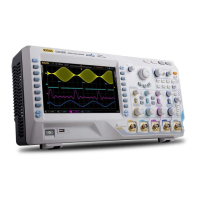Chapter 5 Trigger RIGOL
DS4000E User’s Guide 5-27
2) Specify the pattern of the current channel
Press Code and turn the multi-function knob to select the desired
pattern. At this point, the pattern of the channel currently selected is
highlighted in red in the pattern setting area displayed at the bottom of the
screen.
: set the pattern of the channel selected to “H”, namely the voltage
level is higher than the trigger level of the channel.
: set the pattern of the channel selected to “L”, namely the voltage
level is lower than the /trigger level of the channel.
: set the pattern of the channel selected to “Don’t Care”, namely this
channel is ignored (this channel is not used as a part of the pattern).
Channels set to “Don’t Care” will be ignored. If all the channels in the
pattern are set to “Don’t Care”, the oscilloscope will not trigger.
, : set the pattern of the channel selected to the rising or falling
edge.
Note: Only a single edge (rising or falling edge) can be specified in the
pattern. If one edge item is currently defined and then another edge
item is defined in another channel in the pattern, the former edge item
defined will be replaced by X (Don’t Care).
3) Adjust the trigger level of the current channel
Turn TRIGGER
LEVEL to adjust the trigger level (please refer to
“
Trigger Level”). The current trigger level is displayed at the upper-right
side of the screen.
Repeat steps 1) to 3) to set the pattern and trigger level of all the channels in
the desired pattern.
2. Specify the trigger mode
Press Sweep to select “Auto”, “Normal” or “Single” (please refer to “Trigger
Mode”). The corresponding status light of the trigger mode currently selected in
the trigger control area (TRIGGER) at the front panel turns on.
3. Set the trigger holdoff and noise rejection
Press Setting to enter the trigger setting submenu. In this submenu:
1) Press Holdoff to adjust the holdoff time (please refer to “Trigger
Holdoff”). The range is from 100 ns to 10 s.
2) Press Noise Reject to turn the noise rejection on or off (please refer to
“
Noise Rejection”).

